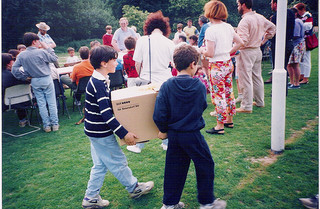The summer break is glorious when you’re a student, and bittersweet once you become a parent. As adults we celebrate the return of long, hot days and the anticipation of a much-needed vacation while we stress out a bit over what to do with the kids for ten or twelve weeks.
I cheer the idea of summer reading programs for students – in fact, I’ve written multiple columns on the concept of fighting the summer brain-drain – and many kids will go off to camp or to stay with relatives.
But another component of building a better student could involve introducing her to the world of philanthropy. After all, there’s no minimum age requirement to give back. Those two months of down-time from school could provide an entirely different education while keeping Ashley and Adam off the couch and away from a glowing screen (albeit briefly).
There’s a lot of squawking over the sense of entitlement in which some young people swim – we’ve all witnessed it. In my experience one of the best ways of combating that all-about-me attitude is to get your child involved with charitable work. And there’s nothing better in the summer than a dirty-hands job, one where he breaks a sweat while doing good for others.
One compelling aspect of giving back is what I call the invisible good. I think young people often only equate charitable work with activities where they actually see the results; handing a dollar to someone in need on a street corner, for instance. They connect the donation with the person receiving it.
But it’s powerful to get a student involved in a program where they never see the final delivery, where they don’t get that immediate emotional payoff.
Volunteering at a food bank is a good example. These storehouses of food and supplies require a significant number of people to handle collections, storage, and delivery before the food ever gets distributed to the agencies that do the actual serving.
Another option might be Habitat for Humanity, a program that builds homes for the needy. The builders may never come into contact with the family that moves in.
Hospitals, libraries, the Red Cross: all of these organizations can use a helping hand, and often you never see the person who ultimately receives the aid.
And why is this important? Well, directly helping others is noble and should be encouraged, but doing the invisible good teaches young people that it’s the act of helping that’s important, not the personal payoff that we get from seeing the final result. The invisible good teaches them that they may never receive a word of thanks from the person in need . . . but that’s not important. It’s the work itself that matters.
There’s something even more noble, I believe, in quietly giving back without needing acknowledgment.
Summer is a great time to get your student involved in a community project. If you can find one where she works behind the scenes for the greater good, it will help to build her character, and will serve her well in the years to come.
Dom Testa is an author, speaker, morning radio show host, and has kept a ficus tree alive for twenty-three years. He’s also the founder and president of The Big Brain Club, a non-profit student development foundation. His new book, Smart Is Cool, will be published in August, 2014. More info at www.DomTesta.com.


